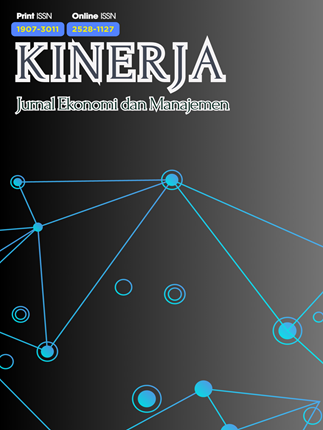Pengaruh marketing mix produk jasa terhadap keputusan berkunjung wisata bahari jawa timur
DOI:
https://doi.org/10.30872/jkin.v17i1.6191Keywords:
Tourism marketing, service markerting mix, visit decisionAbstract
Penelitian ini bertujuan untuk mengetahui pengaruh marketing mix terhadap keputusan berkunjung di wisata Bahari Jawa Timur. Marketing mix dalam penelitian ini menggunakan 7 (tujuh) dimensi yang terdiri atas: produk, harga, promosi, lokasi, orang, proses, bukti fisik. Penelitian ini berfokus kepada pengunjung wisata bahari (pantai dan wisata buatan bertema bahari) khususnya di daerah Pasuruan dan Probolinggo. Penelitian ini menggunakan metode deskriptif kuantitatif. Instrumen penelitian ini menggunakan angket untuk kepentingan survei. Populasi penelitian ini adalah mahasiswa program sarjana manajemen yang berdomisili di Surabaya, Pasuruan dan Probolinggo. Teknik pengambilan sampel dalam penelitian ini menggunakan model CFA. Model ini ini dilengkapi dengan rumus Alpha Cronbach untuk menguji hipotesis yang diajukan. Hasil analisa menunjukkan bahwa marketing mix yang terdiri atas 7 (tujuh) dimensi yang menjadi variabel produk, harga, promosi, lokasi, orang, proses dan bukti fisik berpengaruh secara parsial terhadap keputusan berkunjung. Penelitian ini juga menemukan bukti bahwa ketujuh variabel yang digunakan menunjukkan pengaruh simultan dalam pengambilan keputusan berkunjung.
References
Allan, M. and Altal, Y. (2016), “Museums and tourism: visitors motivations and emotional involvementâ€, Mediterranean Archaeology & Archaeometry, Vol. 16 No. 3, pp. 43-50.
Alvarez, C. and Fournier, S. (2016), “Consumers’ relationships with brandsâ€, Current Opinion in Psychology, Vol. 10, pp. 129-135.
Antoniou, A. (2017), “Social network profiling for cultural heritage: combining data from direct and indirect approachesâ€, Social Network Analysis and Mining, Vol. 7 No. 1, p. 39.
Chen, C.M. and Lin, Y.C. (2018), “Understanding the motivation of museums, galleries and cultural exhibition visits – evidence from Taiwan internet use typesâ€, Current Issues in Tourism, Vol. 21 No. 11, pp. 1215-1220.
Dieck, M.C. and Jung, T. (2018), “A theoretical model of mobile augmented reality acceptance in urban heritage tourismâ€, Current Issues in Tourism, Vol. 21 No. 2, pp. 154-174.
Elbedweighy, A.M., Jayawardhena, C., Elsharnouby, M.H. and Elsharnouby, T.H. (2016), “Customer relationship building: The role of brand attractiveness and consumer-brand identificationâ€, Journal of Business Research, Vol. 69 No. 8, pp. 2901-2910.
Fianto, Achmad Yanu Alif (2018), “Antecedents of Customer Satisfaction for Small Medium Entreprises Product in Indonesiaâ€, International Journal of Civil Engineering and Technology, 9(11), 2018, pp. 2691–2702.
Gilovich, T., Kumar, A. and Jampol, L. (2015), “A wonderful life: Experiential consumption and the pursuit of happinessâ€, Journal of Consumer Psychology, Vol. 25 No. 1, pp. 152-165.
Granitz, N. and Forman, H. (2015), “Building self-brand connections: Exploring brand stories through transmedia perspectiveâ€, Journal of Brand Management, Vol. 22, No. 1, pp. 38-59.
Hammerl, M., Dorner, F., Foscht, T. and Brandstätter, M. (2016), “Attribution of symbolic brand meaning: The interplay of consumers, brands and reference groupsâ€, Journal of Consumer Marketing, Vol. 33 No. 1, pp. 32-40.
He, Y., Chen, Q. and Alden, D.L. (2015), “Time will tell: Managing post-purchase changes in brand attitudeâ€, Journal of the Academy of Marketing Science, DOI:10.1007.
He, Z., Wu, L. and Li, X.R. (2018), “When art meets tech: the role of augmented reality in enhancing museum experiences and purchase intentionsâ€, Tourism Management, Vol. 68, pp. 127-139.
Irimias, A., Mitev, A. and Michalko, G. (2016), “Demographic characteristics influencing religious tourism behaviour: evidence form a Central-Eastern-European Countryâ€, International Journal of Religious Tourism and Pilgrimage, Vol. 4 No. 4, p. 3.
Iyer, P.P., Paswan, A.K. and Davari, A. (2016), “Brands, love and familyâ€, Journal of Product and Brand Management, Vol. 25 No. 1, pp. 69-83.
Karjaluoto, H., Munnukka, J. and Kiuru, K. (2016), “Brand love and positive word of mouth: The moderating effects of experience and priceâ€, Journal of Product and Brand Management, Vol. 25 No. 6, pp.527-537.
Mittal, B. (2015), “Self-concept clarity: Exploring its role in consumer behaviourâ€, Journal of Economic Psychology, Vol. 46, pp. 98-110.
Prat, F.J.M. and Canoves, V.G. (2017), “Analyze of motivation and satisfaction of the visitors to the museum of history of Gironaâ€, Pasos Revista De Turismo y Patrimonio Cultural, Vol. 15 No. 2, pp. 375-389.
Radder, L. and Han, X. (2015), “An examination of the museum experience based on pine and gilmore’s experience economy realmsâ€, Journal of Applied Business Research (JABR), Vol. 31 No. 2, pp. 455-470.
Randhawa, P., Calantone, R.J. and Voorhees, C.M. (2015), “The pursuit of counterfeited luxury: An examination of the negative side effects of close consumer-brand connectionsâ€, Journal of Business Research, Vol. 68, No. 11, pp. 2395-2403.
Schmitt, B., Brakus, J.J. and Zarantonello, L. (2015), “From experiential psychology to consumer experienceâ€, Journal of Consumer Psychology, Vol. 25 No. 1, pp. 166-171.
Sicilia, M., Delgado-Ballester, E. and Palazon, M. (2016), “The need to belong and self-disclosure in positive word-of-mouth behaviours: The moderating effect of self-brand connectionâ€, Journal of Consumer Behaviour, Vol. 15, No. 1, pp. 60-71.
Sim, G., Cassidy, B. and Read, J.C. (2018), “Crowdsourcing ideas for augmented reality museum experiences with childrenâ€, Museum Experience Design, Springer, Cham, pp. 75-93.
Sreejesh, S., Sarkar, A. and Roy, S. (2016), “Validating a scale to measure consumer’s luxury brand aspirationâ€, Journal of Product and Brand Management, Vol. 25 No. 2, pp. 465-478.
Vermeeren, A.P., Calvi, L., Sabiescu, A., Trocchianesi, R., Stuedahl, D., Giaccardi, E. and Radice, S. (2018), “Future museum experience design: crowds, ecosystems and novel technologiesâ€, Museum Experience Design, Springer, Cham, pp. 1-16.
Ye, S., Li, J., Zeng, Z. and Hao, S. (2015), “Research on the impact of social circles on self-rand connection: Regulation of self-awareness and brand valueâ€, Open Journal of Business and Management, Vol. 3 No. 2, pp. 155-162.
Zhang, M. and Aggarwal, P. (2015), “Looking ahead or looking back: Current evaluations and the effect of psychological connectedness to a temporal selfâ€, Journal of Consumer Psychology, Vol. 25 No. 3, pp. 512-518.


